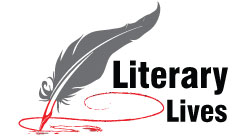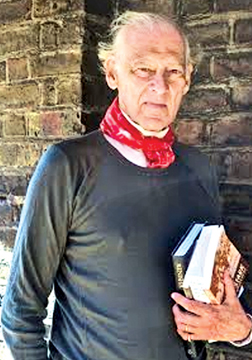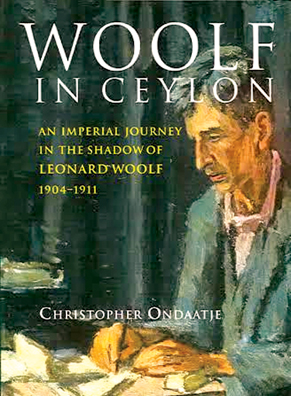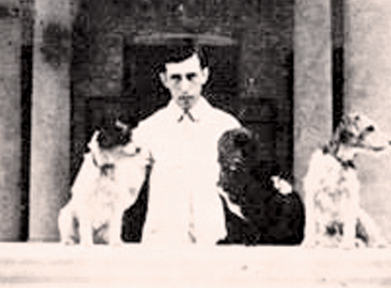Who's afraid of Leonard Woolf ?
"It was a
strange world, a world of hope and brutal facts, of superstition, of
grotesque imagination; a world of trees and the perpetual twilight of
their shade; a world of hunger and fear and devils, where a man was
helpless before the unseen and unintelligible powers surrounding him."
Leonard WoolfThe Village in the Jungle
 It
is a sweltering hot, humid afternoon. There is not much wind. I am
sitting here writing in a wildlife bungalow on the western perimeter of
the Yala National Park overlooking Bandanarewa - a small reservoir only
a few miles for Beddagama (which means literally village in the jungle)
and the site of Leonard Woolf's acclaimed masterpiece The Village in the
Jungle, which was published in 1913 two years after the author had left
Ceylon. Yala's arid and sandy terrain is really of group of five Parks,
covering almost four hundred square miles. It emerged from the reserve
set up at the turn of the last century by British sportsmen interested
in controlled hunting. It's first warden was Henry Engelbrecht who had
come to Ceylon as a prisoner of war in 1905. Because he wouldn't swear
allegiance to the British Crown he was not allowed to return home - so
he stayed on. Woolf described him as "hated", "very stupid" and
"completely without fear and without nerves". He apparently had three
local wives and numerous children. He wasn't much liked. It
is a sweltering hot, humid afternoon. There is not much wind. I am
sitting here writing in a wildlife bungalow on the western perimeter of
the Yala National Park overlooking Bandanarewa - a small reservoir only
a few miles for Beddagama (which means literally village in the jungle)
and the site of Leonard Woolf's acclaimed masterpiece The Village in the
Jungle, which was published in 1913 two years after the author had left
Ceylon. Yala's arid and sandy terrain is really of group of five Parks,
covering almost four hundred square miles. It emerged from the reserve
set up at the turn of the last century by British sportsmen interested
in controlled hunting. It's first warden was Henry Engelbrecht who had
come to Ceylon as a prisoner of war in 1905. Because he wouldn't swear
allegiance to the British Crown he was not allowed to return home - so
he stayed on. Woolf described him as "hated", "very stupid" and
"completely without fear and without nerves". He apparently had three
local wives and numerous children. He wasn't much liked.
Leonard Woolf was born in London in 1880 into a prominent and wealthy
Jewish family. After a spirited five years at Trinity College, Cambridge
where he established lasting friendships with young men like Lytton
Strachey, E.M. Forster and John Maynard Keynes, he applied for the Civil
Service expecting a position with the Home Office. However, with
disappointing examination results, he was only offered a post overseas
and he was sent out in 1904 to Ceylon (now Sri Lanka) as a cadet in the
Ceylon Civil Service - an appointed group of white administrators who
ruled the island.
 Woolf
disembarked in Colombo and spent two weeks at the Kachcheri (office)
signing letters for the Colonial Secretary. He next set out to take up
his first appointment as a Cadet in Jaffna, a province (one of nine) in
the very north of the island. Jaffna, until recently the devastated
stronghold of the Tamil Tigers (LTTE) in their battle for independence
against the Sinhala controlled island, was in those days an area of
sandy austerity encompassing a ? mile long peninsula that curved towards
the southern tip of India. To get there he traveled by train to
Anuradhapura, and then by mail coach - "an ordinary bullock cart in
which the mail bags lay on the floor and the passengers lay on the mail
bags". The last few miles to the Jaffna peninsula were again by train. A
fierce blazing sun shone down on this flat unforgiving land populated
almost exclusively (except for a few hundred Muslims) by the
predominantly Hindu Tamils. Woolf
disembarked in Colombo and spent two weeks at the Kachcheri (office)
signing letters for the Colonial Secretary. He next set out to take up
his first appointment as a Cadet in Jaffna, a province (one of nine) in
the very north of the island. Jaffna, until recently the devastated
stronghold of the Tamil Tigers (LTTE) in their battle for independence
against the Sinhala controlled island, was in those days an area of
sandy austerity encompassing a ? mile long peninsula that curved towards
the southern tip of India. To get there he traveled by train to
Anuradhapura, and then by mail coach - "an ordinary bullock cart in
which the mail bags lay on the floor and the passengers lay on the mail
bags". The last few miles to the Jaffna peninsula were again by train. A
fierce blazing sun shone down on this flat unforgiving land populated
almost exclusively (except for a few hundred Muslims) by the
predominantly Hindu Tamils.
Woolf spent two and a half years, from 5th January 1905 to 19th
August 1907 attached to the Jaffna Kachcheri responsible to the
Government Agent. He was then twenty four years old and his letters back
home (especially to Lytton Strachey) together with his autobiography
Growing (1961) gave a comprehensive and frank expression of his
thoughts, feelings, sentiments and recall of his time in Jaffna and
indeed his entire seven years in Ceylon. He describes some of his own
liabilities, one of which he believed was "the social defect which I
have suffered from ever since I was a child," ...... namely that he was
mentally and physically a coward.
Community
The white community in Jaffna when Woolf arrived there, consisted of
a dozen Government officers, some ten missionaries, and an ex-army
officer "with an appalling wife and an appalling son". Woolf developed
an outspoken, confident and almost arrogant attitude. Nevertheless, with
his superior Agent away attending to municipal responsibilities, Woolf
was often in charge of the entire province. In a letter to Strachey he
laments "but there is nothing to say to you, nothing to tell you of
except 'events'. I neither read nor think nor - in the old way - feel".
Of these events Woolf mentions the loss of his virginity to a "Burgher"
girl. He developed typhoid; was sent to Bandarawela to convalesce; and
later suffered from chronic malaria. He learned Tamil first during his
stay in Jaffna and Sinhala later after he was promoted and sent to Kandy
on 19th August 1907.
As soon as Woolf got to Kandy he realised that he had entered into an
entirely new world - very different from the "flat, dry, hot low country
with a very small rainfall which comes mainly in a month or so of the
north-east monsoon." Kandy was then a town of 30,000 inhabitants and
unlike Jaffna, was "full of white men". There was an air of European
Cosmopolitanism, which to Woolf was extremely distasteful, and it did a
great deal to complete Woolf's education as an anti-imperialist.
Beauty spot
The climate of course was a great deal better than Jaffna- being
"hill country" and more than 1500 feet above sea level - a "beauty spot"
easily accessible from Colombo. Woolf's sister Bella came out at the end
of 1907 to stay with him - and she stayed until he was transferred to
Hambantota in August 1908. This made a great deal of difference to
Woolf's life in Kandy. Woolf played tennis, squash and hockey, and his
day usually ended at the Kandy Club - "a symbol and centre of British
imperialism". Perhaps the most exalted social responsibility of Woolf
during his stay in Kandy was entertaining the ex-Empress Eugenie of
France showing her the Dalada Maliyana which housed, as it does today,
Buddha's tooth - one of the most sacred of Buddhist relics.
 Hosting
Sir Hugh Clifford, the Colonial Secretary, to escort the Empress; and
then later organising an evening of Kandyan dancing at the King's
Pavilion somehow impressed Clifford enough to influence his appointment
as Assistant Government Agent in Hambantota sometime later. Certainly
the most unpleasant work Woolf had to do in Kandy, and indeed everywhere
in Ceylon, had to do with prisons. Hosting
Sir Hugh Clifford, the Colonial Secretary, to escort the Empress; and
then later organising an evening of Kandyan dancing at the King's
Pavilion somehow impressed Clifford enough to influence his appointment
as Assistant Government Agent in Hambantota sometime later. Certainly
the most unpleasant work Woolf had to do in Kandy, and indeed everywhere
in Ceylon, had to do with prisons.
Duties
One of his duties was to be present in a prison when anyone was
flogged or hanged, and to certify that the sentence had been carried
out. "The flogging of a man with a cat-o-nine tails is the most
disgusting and barbarous thing I have ever seen - it is worse than a
hanging." Woolf was repulsed with capital punishment. Although he
believed that law and order should be strictly maintained Woolf believed
that much of British criminal law was an uncivilised method of punishing
and deterring crime.
Woolf's efficiency and organisational abilities after only a year in
the post of Office Assistant in Kandy convinced the Colonial Secretary,
Sir Hugh Clifford, that he should recommend Woolf as Assistant
Government Agent in Hambantota - the youngest AGA in the British Civil
Service.
Woolf arrived in Hambantota as AGA and took over from his predecessor
on Friday 28th August 1908. He eventually left it on leave for England
on Saturday 20th May 1911. It was the third and final phase of Woolf's
stint as a British Civil Servant. Long before this he had almost given
up his weekly letters to Lytton Strachey. The Hambantota district was a
1000 square mile hot, dry, malarial area bounded on the south by the sea
in the south-eastern corner of Ceylon. Again it was different from the
comfortable hill country climate of Kandy and the uncomfortable arid
unprotected Jaffna peninsula. It was almost entirely a jungle area and
had a population of about 100,000. He was given the Residency in
Hambantota to live in on a high promontory jutting out to sea
overlooking the harbour "with walls of astonishing thickness and an
enormously broad verandah and vast high rooms". I know the Residency
well. It is very near the Hambantota rest-house and only about twenty
miles from where I am sitting today in Yala. I have spent many hours at
night listening to the unique smacking sound that the sea made as its
waves rose and fell on the beautiful curved beach below us. It made the
same impression on Woolf.
"All year round day and night, if you looked down that long two-mile
line of sea and sand, you would see, unless it was very rough,
continually at regular intervals a wave, not very high but unbroken two
miles long, lift itself up very slowly, wearily, prise itself, for a
moment in sudden complete silence and then fall with a great thud upon
the sand. The moment of complete silence followed by the great thud, the
thunder of the wave, became part of the rhythm of my life."
There were no other Europeans in the town. Working sixteen hours a
day and being responsible for salt and rice production, education,
combating cattle disease, judging local disputes, and looking after
visiting dignitaries, Woolf made the area the most efficiently governed
in the country. He was tireless and spent his almost three years in the
district riding his horse, walking, traveling in a bullock car and
bicycling over the entire area; his severe administrative work ethic did
not always make him popular but he achieved results and enormous
respect. Woolf also, although he detested big-game hunting, developed a
fascination for the wildlife in the area and for the jungle. Sometimes
alone but often with Henry Engelbrecht, he experience some alarming
encounters in the Magampattu jungle very near here, once literally
digging out a wounded leopard from a cave which Woolf luckily shot at
point blank range when it charged. A terrifying experience.
Woolf's diaries
Every AGA in the island was required to keep a daily diary of his
work. Woolf's diaries with a long erudite introduction were published in
1962. His working day is documented in detail. Being an inveterate
letter writer nearly all other of Woolf's experiences in Ceylon are
thankfully preserved in 125 letters, edited by Frederic Spotts,
published in 1989.
 Most
of these, and by far the most outspoken, are those written to Lytton
Strachey. Other revealing correspondence was to Saxon Sydney-Turner, R.C.
Trevelyan, G.E. Moore, Desmond McCarthy and John Maynard Keynes. This
correspondence was an obvious emotional lifeline for Woolf and it is
unfortunate that letters to his family have been lost as they may have
revealed something other than the political and geographical issues of
which he wrote to his Cambridge associates. Most
of these, and by far the most outspoken, are those written to Lytton
Strachey. Other revealing correspondence was to Saxon Sydney-Turner, R.C.
Trevelyan, G.E. Moore, Desmond McCarthy and John Maynard Keynes. This
correspondence was an obvious emotional lifeline for Woolf and it is
unfortunate that letters to his family have been lost as they may have
revealed something other than the political and geographical issues of
which he wrote to his Cambridge associates.
Apart from these letters, his diary, and three short stories
published in 1920 (?) under the title Stories of the East, only the
masterfully empathetic The Village in the Jungle (which many believe had
an authenticity unequaled even in works by Conran and Forster), remained
of Leonard Woolf's writings in Ceylon.
This was until his autobiography Growing was published in 1961 when
he was eighty years old. In Growing Woolf tells the complete story of
his seven years as a civil servant in Ceylon, and it is obvious that he
applied the same method to the towns and jungles as he did to the
Sinhalese and Tamils, and to the strange Anglo-Ceylon society into which
he was plunged when he was twenty-four years old. Today, almost a
century later, it presents a vivid picture of a curious way of life
which has already disappeared. |

